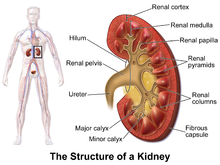| Nephritic syndrome | |
|---|---|
| Other names | Acute nephritic syndrome[1] |
 | |
| A graphic representation of the kidney. | |
| Specialty | Nephrology |
| Symptoms | Oliguria[2] |
| Causes | Infectious, autoimmune, or thrombotic[3] |
| Diagnostic method | Urinalysis, kidney biopsy[4] |
| Treatment | Antihypertensives[5] |
Nephritic syndrome is a syndrome comprising signs of nephritis, which is kidney disease involving inflammation. It often occurs in the glomerulus, where it is called glomerulonephritis. Glomerulonephritis is characterized by inflammation and thinning of the glomerular basement membrane and the occurrence of small pores in the podocytes of the glomerulus. These pores become large enough to permit both proteins and red blood cells to pass into the urine (yielding proteinuria and hematuria, respectively). By contrast, nephrotic syndrome is characterized by proteinuria and a constellation of other symptoms that specifically do not include hematuria.[6] Nephritic syndrome, like nephrotic syndrome, may involve low level of albumin in the blood due to the protein albumin moving from the blood to the urine.[7]
- ^ "acute nephritic syndrome" at Dorland's Medical Dictionary
- ^ Cite error: The named reference
Madarawas invoked but never defined (see the help page). - ^ Cite error: The named reference
causewas invoked but never defined (see the help page). - ^ Cite error: The named reference
NIHwas invoked but never defined (see the help page). - ^ Cite error: The named reference
treatwas invoked but never defined (see the help page). - ^ Ferri, Fred F. (2017-05-25). Ferri's clinical advisor 2018 : 5 books in 1. Preceded by: Ferri, Fred F. Philadelphia, PA. p. 889. ISBN 978-0-323-52957-0. OCLC 989151714.
{{cite book}}: CS1 maint: location missing publisher (link) - ^ Schrier, Robert W. (2010). Renal and Electrolyte Disorders. Lippincott Williams & Wilkins. pp. 559–560. ISBN 978-1-60831-072-2.